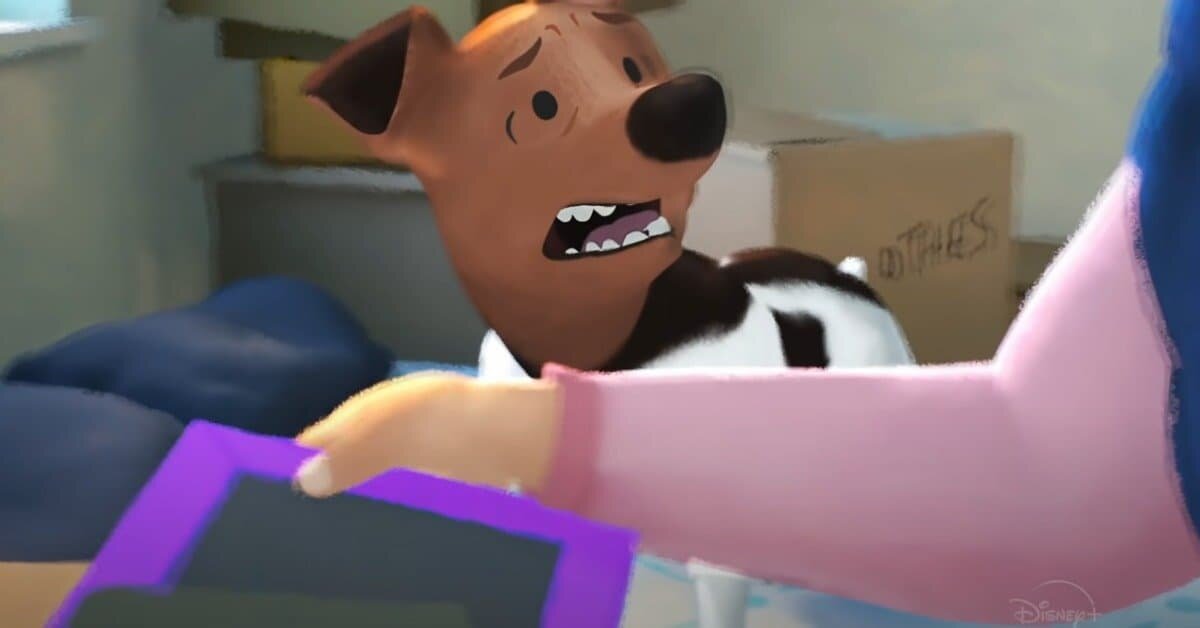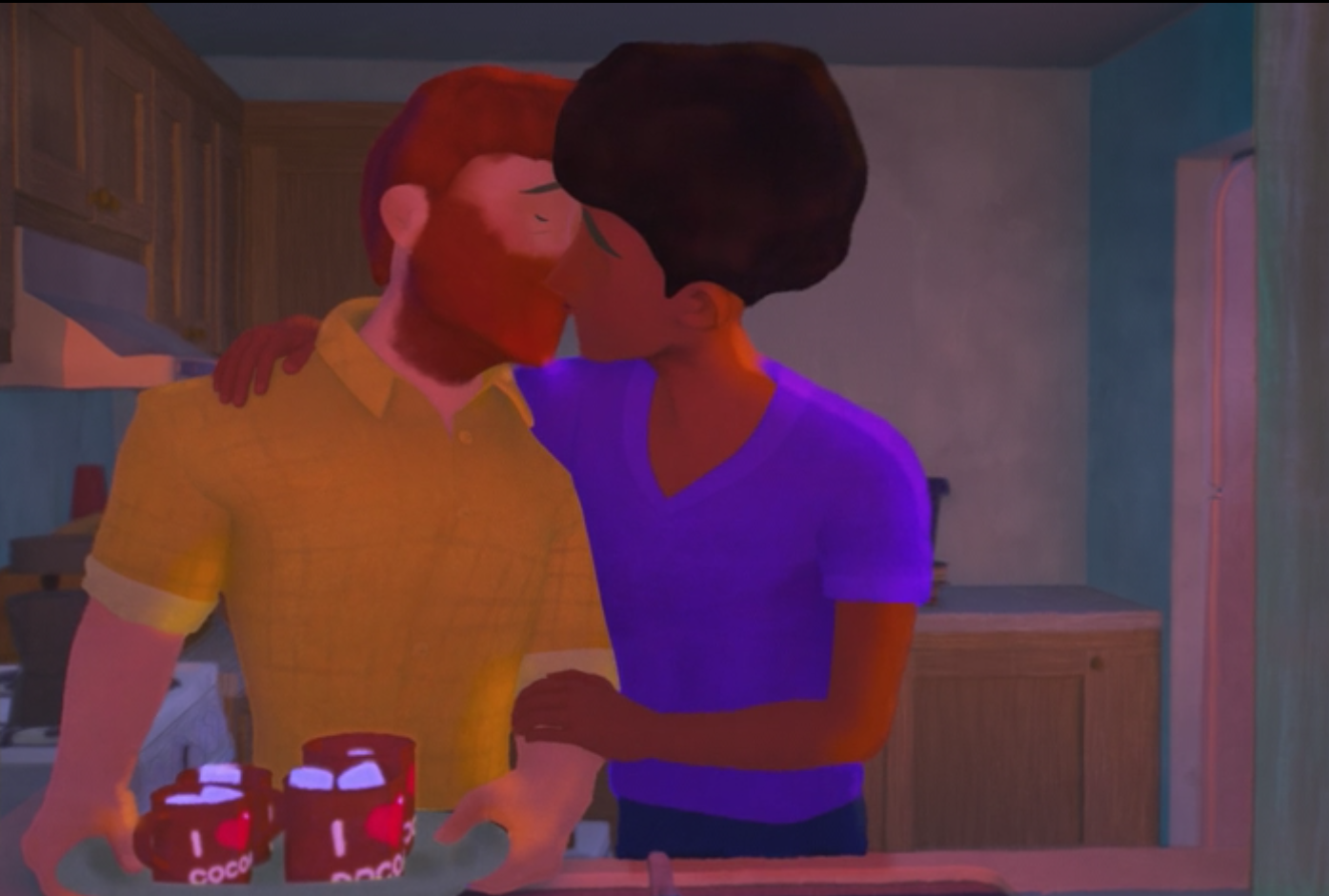Pixar's Out (Steven Clay Hunter, 2020)
Featuring Pixar’s first LGBTQ+ lead, Out (Steven Clay Hunter, 2020) is a delightful, whimsical tale of love and queer identity. The short plays out as a comical exploration of the challenges faced by Greg, its lead character, when he finds himself about to be prematurely outed to his parents. Premiering on Disney+ in 2020, Out provides a rare instance of LGBTQ+ representation in the world of Disney (by way of Pixar). Recently, Toy Story 4 (Josh Cooley, 2019) featured a brief glimpse of a lesbian couple dropping their child off at a nursery, while in Onward (Dan Scanlon, 2020) a lesbian police officer speaks often of her partner, yet queerness has only ever been addressed allusively and/or peripherally (consider LeFou in the live action Beauty and the Beast (Bill Condon, 2017) remake, or a blink-and-you’ll-miss-it same-sex kiss during the finale of Star Wars: The Rise of Skywalker [J.J. Abrams, 2019]). Out is the first Disney/Pixar film to directly address sexuality, placing undeniably queer characters at its centre.
Out begins with Greg and his boyfriend, Manuel, moving to a new house when Greg’s parents unexpectedly drop by to help. In a panic, Greg attempts to conceal any evidence of his boyfriend or sexuality and instinctively wishes to swap places with his dog. His wish is granted and chaos ensues as the film adopts the premise of a body swap comedy (à la Freaky Friday (1976/2003). The dog, now in Greg’s body, excitedly runs into walls, chases a squirrel, and causes a fire by knocking over a BBQ, baffling Greg’s parents with his behaviour. However, the narrative primarily focuses on Greg in dog-form as he desperately attempts to conceal any references to his sexuality that appear around the house, in particular, the framed photo of Manuel and him sharing a cup of hot cocoa (Fig. 1). Dog-Greg’s inability to communicate with his mother is quickly established as a metaphor for his difficulty, and indeed the difficulty many queer people face, in coming out. It is this difficulty that Out aptly portrays in an entertaining and effective way, normalising via comedy tropes the emotionally resonant experience of coming out.
Out begins with the statement: “based on a true story”. Cut to a rainbow road, an icon of LGBTQ+ identity, which appears in the sky. A purple cat and a pink dog[1] jump from the road and land on a hill, where they observe a nearby house. “Darling, just keep watching… something will happen… something magical”, the cat knowingly tells the dog. The cat blows a shimmering, purple bubble which lands on Greg’s dog’s collar, knocking it off and thus setting the stage for Greg’s transformation. The film’s fantastical opening contrasts the true story framing device, as well as the potentially dramatic narrative, but stays true to Pixar’s frequent utilisation of the fantasy genre, as well as their tendency to cast difficult topics in a light-hearted way. Writer/director Steven Clay Hunter explains that this choice “started mostly as a joke … [but that he] really wanted to create the fairy tale version of a coming out story that felt true to our experiences” (Clay Hunter 2020). By exploring the subject through the genre of fantasy, Out includes queer identification within the larger history of animation and its popular genres, whilst highlighting the difficulty some people experience in coming out. Note that it is more conceivable for Greg to imagine himself transforming into a dog than it is for him to imagine being able to communicate transparently with his parents. The narrative thus becomes, not "a denial of reality, but an escape into a spiritual or inner journey" (Fowkes 2010, 9) that concludes with a public act of becoming.
Greg fantasises about becoming a dog because he believes that life would be easier if he could just avoid having to come out at all. As he makes his wish, his dog’s collar fixes itself tightly around his neck, and he becomes symbolically imprisoned by the wish to conceal his true self. After the transformation occurs, Greg endures a series of challenges, much like the heroes of many fantasy narratives – an arc which can be understood through Tolkien’s essay On Fairy Stories (1947). Tolkien argues that the hero must endure different challenges as they pass through the stages of recovery, escape, and, finally, consolation. This narrative arc tasks the hero with obstacles that, having overcome them, provides a renewed perspective of their circumstances by the end. Out’s fantasy narrative accordingly provides Greg with a series of opportunities to address his sexuality in his parents’ presence, culminating in a clash with his mother in which he has no choice but to bite her to prevent her from seeing the framed photo of Manuel and him (Fig. 2).
While the harm Greg causes runs counter to his goal not to hurt his parents, the bite nevertheless provides the opportunity for a conversation between mother and son. Although Greg’s mother is unaware that she is communicating with her son and not his dog, Greg still gains a new understanding of his mother’s perspective. “This hurts… this really hurts”, she states, before moving into a heartfelt monologue in which she is finally able to communicate, albeit obliquely, with her son. Expressing her hurt that Greg is moving so far away (Fig. 3), she states that she hopes one day, that he finds someone, “and that whoever it is… well… that he makes [Greg] happy”. This tender moment between the two provides a happy opportunity for reconciliation over the fact of Greg’s sexuality. Through this fantasy narrative, Greg is able to acquire a "re-gaining of a clear view" (Tolkien 1947, 28) and not only gather the courage to come out, but also address the breakdown of communication that has formed between him and his parents. Indeed, Greg’s mother already knew about her son’s sexuality, a rare instance that normalises LGBTQ+ relationships by eradicating a cultural presumption that a person is heterosexual unless they are out. In Out’s final scene, Greg (now human once again) makes cocoa for his family, mirroring the photo of Manuel and him and visually indicating his newfound openness with his parents (Fig. 4). This resolution is made possible by Greg’s transformations, both physically (becoming a dog) and emotionally (struggling with and then accepting his sexuality). Likewise, the spectator is encouraged towards an empathetic understanding of the universal pain of denying one’s nature and the experience of coming out. Ultimately, the representation of queer identity, as well as the normalising of same-sex relationships, goes beyond simply making Pixar’s films specifically more diverse (as cynical inclusions of queerness as background fodder have done) and provides a vehicle for under-represented viewers to locate their own experiences on-screen.
Exploring the process of coming out through fantasy and animation allows the narrative to play out in a light-hearted, heart-warming, and comedic way. Out offers a refreshing focus on LGBTQ+ identities, with its representation focally positioned within the narrative, as opposed to becoming buried in allusion and/or the background, as has often been the case with animated film. However, despite Out’s open celebration of queer love, this film, limited to the short format on the Disney+ platform, is only a stepping stone in quest to normalising LGBTQ+ representation within mainstream animation. This leaves us, as queer people, hoping that what comes next will be a more diverse and inclusive form of representation in future films.
**Article published: February 12, 2021**
Notes
[1] Pink and purple, which have antecedents in camp culture, are significant colours in the film. Greg’s and Manuel’s photo is framed in pink and purple, Greg’s dog’s collar is purple, and Greg’s mother’s shirt is pink because, according to Clay Hunter, “Greg’s Mom is aware of his truth, so we decided to give her the pink shirt to hint at that” (Clay Hunter 2020).
References
Clay Hunter, Steven. 2020. “Interview with ‘Out’ director Steven Clay Hunter.” Skwigly, June 25, 2020. https://www.skwigly.co.uk/interview-with-out-director-steven-clay-hunter/
Fowkes, Katherine A. 2010. The Fantasy Film. Chichester: Wiley-Blackwell.
Melnyk, George. 2014. Film and the City: The Urban Imaginary in Canadian Cinema. Edmonton: AU Press.
Rösing, Lilian Munk. 2016. Pixar With Lacan: The Hysteric’s Guide to Animation. London: Bloomsbury.
Tolkien, J.R.R.. 1947. “On Fairy Stories.” Coolcalvary, October, 2018. 28.
Biography
Jade Evans is an AHRC funded PhD candidate at QMUL researching British film stars, the embodiment of literary figures, and national identity between 1920 – 1970 in a collaborative project with the BFI Archives. She is a member of the BAFTSS LGBTQ+ Scholarly Interest Group, where she takes part in a monthly discussion around a nominated text.




